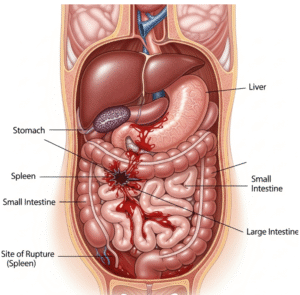What it is
A Cesarean section (C-section) is a surgical procedure used to deliver a baby through incisions in the mother’s abdomen and uterus. It is one of the most common obstetric surgeries worldwide and is performed when vaginal delivery poses risks to the mother or baby.
In Korea, C-sections are conducted in modern hospitals with highly skilled surgeons, anesthesiologists, and advanced facilities. The procedure may be planned (elective) or unplanned (emergency) depending on the situation.
➡️ Key points about C-sections:
- Planned (elective) C-section: Scheduled in advance for medical or personal reasons
- Emergency C-section: Performed quickly due to sudden complications during labor
- Safe and standardized in Korea with strong emphasis on recovery support
Why it’s done
C-sections are performed when a vaginal delivery is not possible or safe.
✔️ Medical reasons for C-section:
- Fetal distress (abnormal heart rate or oxygen supply issues)
- Prolonged or obstructed labor where progress stalls
- Breech presentation (baby positioned feet- or buttocks-first)
- Placenta previa (placenta covering the cervix)
- Multiple pregnancies (twins or triplets with complications)
- Previous uterine surgery or multiple C-sections increasing rupture risk
- Maternal health issues such as high blood pressure, diabetes, or infections
✔️ Elective reasons:
- Mother’s preference due to fear of vaginal delivery pain or prior traumatic birth
- Desire for scheduled delivery date
✔️ Benefits:
- Provides safe delivery when vaginal birth is high-risk
- Reduces potential complications for mother and baby in critical conditions
Alternatives
While C-section is a lifesaving procedure, it is not always the first choice. Alternatives may be explored depending on circumstances.
🔹 Vaginal delivery:
- Preferred if no medical risks exist
- Promotes faster recovery and fewer surgical risks
🔹 Assisted vaginal delivery:
- Forceps or vacuum extraction used if labor slows but vaginal delivery is possible
🔹 Trial of labor after C-section (TOLAC):
- Some women with prior C-sections can attempt a vaginal birth if the uterus is strong and risks are low
- Requires careful monitoring to prevent uterine rupture
Preparation
Before undergoing a C-section, preparation ensures safety for both mother and baby.
➡️ Medical preparation:
- Full health evaluation including blood pressure, blood sugar, and lab tests
- Ultrasound to check baby’s position and placenta location
- Anesthesia consultation to decide between spinal, epidural, or general anesthesia
➡️ Personal preparation:
- Discussing the birth plan with the obstetrician
- Packing hospital essentials for an extended stay (4–7 days on average in Korea)
- Arranging family support for postpartum recovery
➡️ Mental preparation:
- Understanding the step-by-step process of surgery
- Attending childbirth classes or counseling sessions for anxiety management
How it’s done
C-sections in Korea are performed with advanced surgical protocols and precise attention to patient comfort.
✔️ Step 1 – Anesthesia
- Spinal or epidural anesthesia is commonly used, allowing the mother to remain awake but pain-free
- In emergencies, general anesthesia may be administered
✔️ Step 2 – Incision
- A horizontal incision (bikini cut) is made across the lower abdomen
- Uterus is carefully opened to reach the baby
✔️ Step 3 – Delivery of the baby
- The baby is lifted out gently
- Immediate care is provided to ensure healthy breathing and vital signs
✔️ Step 4 – Placenta removal
- The placenta is removed and the uterus is cleaned to reduce infection risks
✔️ Step 5 – Closure
- Uterus and abdominal layers are stitched with absorbable sutures
- Sterile dressing applied to the incision site
✔️ Duration:
- Surgery usually lasts 30–60 minutes
- The baby is delivered within the first 10–15 minutes of the procedure
Recovery
Recovery from C-section is longer than from vaginal delivery but with proper care, mothers heal well.
➡️ Immediate recovery:
- Hospital stay of 4–7 days in Korea
- Pain managed with medications and mobility encouraged within 24 hours
- Monitoring for bleeding, infection, or blood clots
➡️ Physical recovery:
- Full healing of incision may take 6–8 weeks
- Mild pain, swelling, or scar sensitivity common
- Avoiding heavy lifting and strenuous activities recommended
➡️ Emotional recovery:
- Some mothers may feel disappointment if C-section was unplanned
- Counseling and family support help ease adjustment
➡️ Tips for smoother recovery:
- Adequate rest and balanced nutrition
- Gentle walking to prevent blood clots
- Proper wound care and hygiene
- Attending scheduled postpartum check-ups
Treatment option in Korea
Korea provides some of the best medical facilities and support systems for C-sections, making it a safe choice for mothers requiring surgical delivery.
✔️ Hospital facilities:
- Modern operating rooms equipped with advanced monitoring technology
- Neonatal intensive care units (NICUs) available for babies needing extra support
- Comfortable recovery rooms and extended hospital stay for maternal care
✔️ Medical expertise:
- Skilled obstetricians and anesthesiologists with high success rates
- Strict infection control and surgical protocols
- Effective pain management plans tailored to each mother
✔️ Postpartum care:
- Access to Sanhujoriwon (postpartum care centers), offering recovery programs, dietary guidance, and physical therapy
- Lactation consultants available to support breastfeeding after surgery
- Counseling services for emotional recovery
✔️ Cultural aspect:
- In Korea, postpartum recovery is taken very seriously
- Mothers often spend 2–3 weeks in specialized centers focusing on rest, nutrition, and bonding with the newborn
➡️ Highlight: Cesarean section in Korea combines world-class medical expertise, advanced surgical care, and holistic postpartum recovery programs, ensuring safety and well-being for both mother and child.













